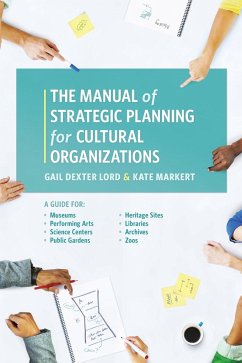Gail Dexter Lord, Kate Markert
The Manual of Strategic Planning for Cultural Organizations
A Guide for Museums, Performing Arts, Science Centers, Public Gardens, Heritage Sites, Libraries, Archives and Zoos
Gail Dexter Lord, Kate Markert
The Manual of Strategic Planning for Cultural Organizations
A Guide for Museums, Performing Arts, Science Centers, Public Gardens, Heritage Sites, Libraries, Archives and Zoos
- Gebundenes Buch
- Merkliste
- Auf die Merkliste
- Bewerten Bewerten
- Teilen
- Produkt teilen
- Produkterinnerung
- Produkterinnerung
The Manual of Strategic Planning for Cultural Organizations adopts a revolutionary approach to the world of museums and cultural institutions. By encompassing a broad group of cultural organizations, this whole-career oriented book responds to the 21st-century reality that boundaries are being blurred among institutional types.
Andere Kunden interessierten sich auch für
The Manual of Strategic Planning for Cultural Organizations adopts a revolutionary approach to the world of museums and cultural institutions. By encompassing a broad group of cultural organizations, this whole-career oriented book responds to the 21st-century reality that boundaries are being blurred among institutional types.
Produktdetails
- Produktdetails
- Verlag: Globe Pequot Publishing Group Inc/Bloomsbury
- Seitenzahl: 198
- Erscheinungstermin: 17. März 2017
- Englisch
- Abmessung: 260mm x 183mm x 15mm
- Gewicht: 578g
- ISBN-13: 9781538101308
- ISBN-10: 1538101300
- Artikelnr.: 46605231
- Herstellerkennzeichnung
- Libri GmbH
- Europaallee 1
- 36244 Bad Hersfeld
- gpsr@libri.de
- Verlag: Globe Pequot Publishing Group Inc/Bloomsbury
- Seitenzahl: 198
- Erscheinungstermin: 17. März 2017
- Englisch
- Abmessung: 260mm x 183mm x 15mm
- Gewicht: 578g
- ISBN-13: 9781538101308
- ISBN-10: 1538101300
- Artikelnr.: 46605231
- Herstellerkennzeichnung
- Libri GmbH
- Europaallee 1
- 36244 Bad Hersfeld
- gpsr@libri.de
By Gail Dexter Lord and Kate Markert
Chapter 1 WHY Conduct a Strategic Plan? 1.1 Forces of Change 1.2
Understanding Your Cultural Organization 1.3 The Significance of
Foundations Statements Case Study 1.1: The Guggenheim Bilbao Strategic
Vision 2020 Case Study 1.2: Why do you Need Libraries Anyway? The County of
Los Angeles Public Library Strategic Plan: A Case Study Case Study 1.3:
Soft Power and The Gardiner Museum's Strategic Plan Chapter 2 WHEN to
Conduct a Strategic Plan 2.1 Professional Standards 2.2 New Director 2.3
New Circumstances 2.4 New and Renewed Facilities and New Location 2.5
Readiness Checklist Case Study 2.1: It's Time for Strategic Planning at the
Whitney Museum of American Art Case Study 2.2: A New Strategic Direction
for the Schomburg Center for Research in Black Culture Chapter 3 WHO AND
WHAT: The Structure of Strategic Planning 3.1 Leadership 3.2 Facilitation
3.3 The Ten Steps of Strategic Planning Case Study 3.1: Tafelmusik's
Strategic Plan for Acoustical Excellence Case Study 3.2: Benefits of
Strategic Planning in Science Centers Chapter 4 HOW: Methods of Engagement
4.1 Principles of Strategic Planning 4.2 Internal Assessment 4.2.3 Using
Technology 4.3 External Assessment Case Study 4.1: Why Strategic Planning
for Cultural Organizations Needs to Include the City Case Study 4.2: How
Art League Houston Engaged Communities Chapter 5 From Problems to
Strategies 5.1 Thinking Strategically 5.2 Identifying Key Issues 5.3
Comparison and Benchmarking 5.4 Construction of Scenarios Case Study 5.1:
The Role of Strategic Planning in Formalizing and Communicating the
Changing Role of the Toronto Zoo Case Study 5.2: A New Governance Strategy
for the Tom Thomson Art Gallery Chapter 6 From Strategies to Goals: The
Strategic Planning Retreat 6.1 Setting Realistic Objectives for the Retreat
6.2 The Retreat Agenda 6.3 Retreat Report Case Study 6.1: Creativity is
Center Stage in Strategic Planning for Roundabout Theatre Company Chapter
7 From Goals to Objectives and Tasks 7.1 Strategic Planning Workbook 7.2
Facilitating the Staff Process Case Study 7.1: Henry Ford Estate - Fair
Lane: A 21st Century Blueprint for an Iconic Historic Home Chapter 8
Implementing the Plan 8.1 Detailing the Plan 8.2 The Financials in the Plan
8.3 The Budget and the Plan 8.4 Alignment with the Organization's
Long-Range Plans 8.5 Alignment with Human Resources Strategy 8.6 Alignment
of Staff and Board 8.7 The Public Dimension: Communicating the Plan Case
Study 8.1: A Great Garden of the World -- Our Planning Story Chapter 9
Evaluating the Strategic Plan 9.1 The Board's Role in Evaluation 9.2
Involving All Board Committees 9.3 Staff Roles in Evaluating the Plan 9.4
The Bigger Question: Are These the Right Goals? Or, Is It Time for a New
Plan? Case Study 9.1: Measuring What Matters in Strategic Planning Case
Study 9.2: Using Metrics to Further Alignment at Hillwood Chapter 10
Conclusion: What Can Go Wrong and How to Fix It
Understanding Your Cultural Organization 1.3 The Significance of
Foundations Statements Case Study 1.1: The Guggenheim Bilbao Strategic
Vision 2020 Case Study 1.2: Why do you Need Libraries Anyway? The County of
Los Angeles Public Library Strategic Plan: A Case Study Case Study 1.3:
Soft Power and The Gardiner Museum's Strategic Plan Chapter 2 WHEN to
Conduct a Strategic Plan 2.1 Professional Standards 2.2 New Director 2.3
New Circumstances 2.4 New and Renewed Facilities and New Location 2.5
Readiness Checklist Case Study 2.1: It's Time for Strategic Planning at the
Whitney Museum of American Art Case Study 2.2: A New Strategic Direction
for the Schomburg Center for Research in Black Culture Chapter 3 WHO AND
WHAT: The Structure of Strategic Planning 3.1 Leadership 3.2 Facilitation
3.3 The Ten Steps of Strategic Planning Case Study 3.1: Tafelmusik's
Strategic Plan for Acoustical Excellence Case Study 3.2: Benefits of
Strategic Planning in Science Centers Chapter 4 HOW: Methods of Engagement
4.1 Principles of Strategic Planning 4.2 Internal Assessment 4.2.3 Using
Technology 4.3 External Assessment Case Study 4.1: Why Strategic Planning
for Cultural Organizations Needs to Include the City Case Study 4.2: How
Art League Houston Engaged Communities Chapter 5 From Problems to
Strategies 5.1 Thinking Strategically 5.2 Identifying Key Issues 5.3
Comparison and Benchmarking 5.4 Construction of Scenarios Case Study 5.1:
The Role of Strategic Planning in Formalizing and Communicating the
Changing Role of the Toronto Zoo Case Study 5.2: A New Governance Strategy
for the Tom Thomson Art Gallery Chapter 6 From Strategies to Goals: The
Strategic Planning Retreat 6.1 Setting Realistic Objectives for the Retreat
6.2 The Retreat Agenda 6.3 Retreat Report Case Study 6.1: Creativity is
Center Stage in Strategic Planning for Roundabout Theatre Company Chapter
7 From Goals to Objectives and Tasks 7.1 Strategic Planning Workbook 7.2
Facilitating the Staff Process Case Study 7.1: Henry Ford Estate - Fair
Lane: A 21st Century Blueprint for an Iconic Historic Home Chapter 8
Implementing the Plan 8.1 Detailing the Plan 8.2 The Financials in the Plan
8.3 The Budget and the Plan 8.4 Alignment with the Organization's
Long-Range Plans 8.5 Alignment with Human Resources Strategy 8.6 Alignment
of Staff and Board 8.7 The Public Dimension: Communicating the Plan Case
Study 8.1: A Great Garden of the World -- Our Planning Story Chapter 9
Evaluating the Strategic Plan 9.1 The Board's Role in Evaluation 9.2
Involving All Board Committees 9.3 Staff Roles in Evaluating the Plan 9.4
The Bigger Question: Are These the Right Goals? Or, Is It Time for a New
Plan? Case Study 9.1: Measuring What Matters in Strategic Planning Case
Study 9.2: Using Metrics to Further Alignment at Hillwood Chapter 10
Conclusion: What Can Go Wrong and How to Fix It
Chapter 1 WHY Conduct a Strategic Plan? 1.1 Forces of Change 1.2
Understanding Your Cultural Organization 1.3 The Significance of
Foundations Statements Case Study 1.1: The Guggenheim Bilbao Strategic
Vision 2020 Case Study 1.2: Why do you Need Libraries Anyway? The County of
Los Angeles Public Library Strategic Plan: A Case Study Case Study 1.3:
Soft Power and The Gardiner Museum's Strategic Plan Chapter 2 WHEN to
Conduct a Strategic Plan 2.1 Professional Standards 2.2 New Director 2.3
New Circumstances 2.4 New and Renewed Facilities and New Location 2.5
Readiness Checklist Case Study 2.1: It's Time for Strategic Planning at the
Whitney Museum of American Art Case Study 2.2: A New Strategic Direction
for the Schomburg Center for Research in Black Culture Chapter 3 WHO AND
WHAT: The Structure of Strategic Planning 3.1 Leadership 3.2 Facilitation
3.3 The Ten Steps of Strategic Planning Case Study 3.1: Tafelmusik's
Strategic Plan for Acoustical Excellence Case Study 3.2: Benefits of
Strategic Planning in Science Centers Chapter 4 HOW: Methods of Engagement
4.1 Principles of Strategic Planning 4.2 Internal Assessment 4.2.3 Using
Technology 4.3 External Assessment Case Study 4.1: Why Strategic Planning
for Cultural Organizations Needs to Include the City Case Study 4.2: How
Art League Houston Engaged Communities Chapter 5 From Problems to
Strategies 5.1 Thinking Strategically 5.2 Identifying Key Issues 5.3
Comparison and Benchmarking 5.4 Construction of Scenarios Case Study 5.1:
The Role of Strategic Planning in Formalizing and Communicating the
Changing Role of the Toronto Zoo Case Study 5.2: A New Governance Strategy
for the Tom Thomson Art Gallery Chapter 6 From Strategies to Goals: The
Strategic Planning Retreat 6.1 Setting Realistic Objectives for the Retreat
6.2 The Retreat Agenda 6.3 Retreat Report Case Study 6.1: Creativity is
Center Stage in Strategic Planning for Roundabout Theatre Company Chapter
7 From Goals to Objectives and Tasks 7.1 Strategic Planning Workbook 7.2
Facilitating the Staff Process Case Study 7.1: Henry Ford Estate - Fair
Lane: A 21st Century Blueprint for an Iconic Historic Home Chapter 8
Implementing the Plan 8.1 Detailing the Plan 8.2 The Financials in the Plan
8.3 The Budget and the Plan 8.4 Alignment with the Organization's
Long-Range Plans 8.5 Alignment with Human Resources Strategy 8.6 Alignment
of Staff and Board 8.7 The Public Dimension: Communicating the Plan Case
Study 8.1: A Great Garden of the World -- Our Planning Story Chapter 9
Evaluating the Strategic Plan 9.1 The Board's Role in Evaluation 9.2
Involving All Board Committees 9.3 Staff Roles in Evaluating the Plan 9.4
The Bigger Question: Are These the Right Goals? Or, Is It Time for a New
Plan? Case Study 9.1: Measuring What Matters in Strategic Planning Case
Study 9.2: Using Metrics to Further Alignment at Hillwood Chapter 10
Conclusion: What Can Go Wrong and How to Fix It
Understanding Your Cultural Organization 1.3 The Significance of
Foundations Statements Case Study 1.1: The Guggenheim Bilbao Strategic
Vision 2020 Case Study 1.2: Why do you Need Libraries Anyway? The County of
Los Angeles Public Library Strategic Plan: A Case Study Case Study 1.3:
Soft Power and The Gardiner Museum's Strategic Plan Chapter 2 WHEN to
Conduct a Strategic Plan 2.1 Professional Standards 2.2 New Director 2.3
New Circumstances 2.4 New and Renewed Facilities and New Location 2.5
Readiness Checklist Case Study 2.1: It's Time for Strategic Planning at the
Whitney Museum of American Art Case Study 2.2: A New Strategic Direction
for the Schomburg Center for Research in Black Culture Chapter 3 WHO AND
WHAT: The Structure of Strategic Planning 3.1 Leadership 3.2 Facilitation
3.3 The Ten Steps of Strategic Planning Case Study 3.1: Tafelmusik's
Strategic Plan for Acoustical Excellence Case Study 3.2: Benefits of
Strategic Planning in Science Centers Chapter 4 HOW: Methods of Engagement
4.1 Principles of Strategic Planning 4.2 Internal Assessment 4.2.3 Using
Technology 4.3 External Assessment Case Study 4.1: Why Strategic Planning
for Cultural Organizations Needs to Include the City Case Study 4.2: How
Art League Houston Engaged Communities Chapter 5 From Problems to
Strategies 5.1 Thinking Strategically 5.2 Identifying Key Issues 5.3
Comparison and Benchmarking 5.4 Construction of Scenarios Case Study 5.1:
The Role of Strategic Planning in Formalizing and Communicating the
Changing Role of the Toronto Zoo Case Study 5.2: A New Governance Strategy
for the Tom Thomson Art Gallery Chapter 6 From Strategies to Goals: The
Strategic Planning Retreat 6.1 Setting Realistic Objectives for the Retreat
6.2 The Retreat Agenda 6.3 Retreat Report Case Study 6.1: Creativity is
Center Stage in Strategic Planning for Roundabout Theatre Company Chapter
7 From Goals to Objectives and Tasks 7.1 Strategic Planning Workbook 7.2
Facilitating the Staff Process Case Study 7.1: Henry Ford Estate - Fair
Lane: A 21st Century Blueprint for an Iconic Historic Home Chapter 8
Implementing the Plan 8.1 Detailing the Plan 8.2 The Financials in the Plan
8.3 The Budget and the Plan 8.4 Alignment with the Organization's
Long-Range Plans 8.5 Alignment with Human Resources Strategy 8.6 Alignment
of Staff and Board 8.7 The Public Dimension: Communicating the Plan Case
Study 8.1: A Great Garden of the World -- Our Planning Story Chapter 9
Evaluating the Strategic Plan 9.1 The Board's Role in Evaluation 9.2
Involving All Board Committees 9.3 Staff Roles in Evaluating the Plan 9.4
The Bigger Question: Are These the Right Goals? Or, Is It Time for a New
Plan? Case Study 9.1: Measuring What Matters in Strategic Planning Case
Study 9.2: Using Metrics to Further Alignment at Hillwood Chapter 10
Conclusion: What Can Go Wrong and How to Fix It



